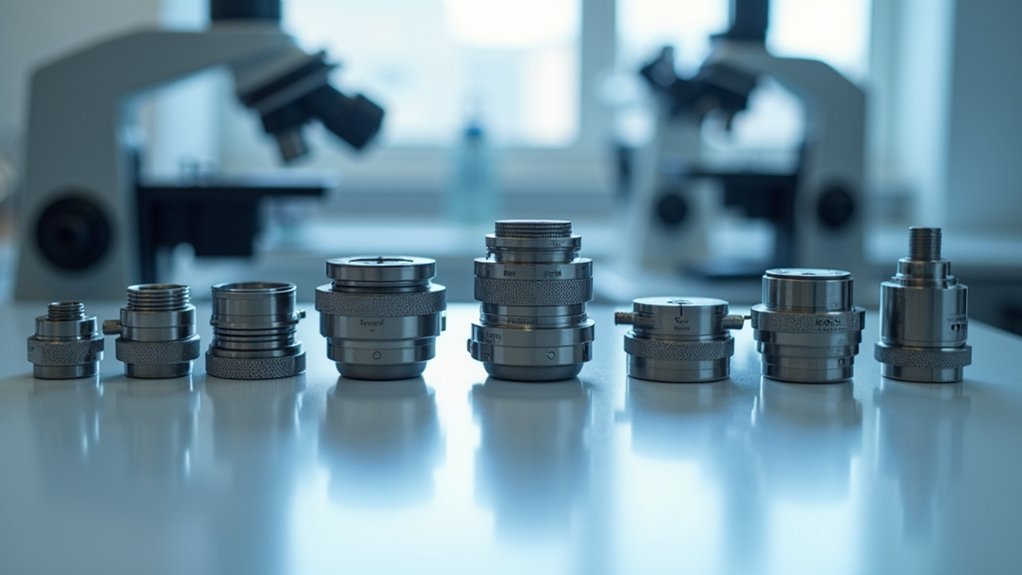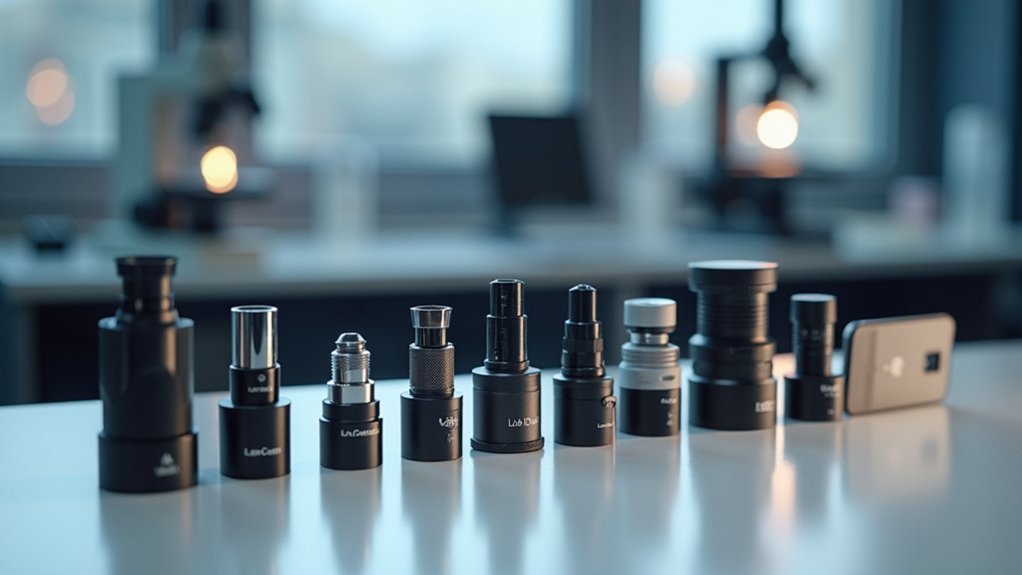The three best camera adapters for your lab optics include C-Mount adapters with their industry-standard threaded ports, SLR microscope adapters offering exceptional resolution for large sensors, and smartphone LabCam adapters providing accessible imaging starting at $169. You’ll need to match your adapter to your specific camera type and research requirements for ideal results. These versatile tools transform your microscope capabilities, with each option delivering unique benefits for your scientific imaging needs.
C-Mount Adapters for Digital Microscopy

When connecting digital cameras to microscopes, C-Mount adapters serve as the industry standard interface that guarantees superior image quality and precise field of view control.
These adapters feature a 1-inch threaded port that enables specific focal depth adjustments for perfect alignment with your microscope camera.
You’ll find various relay lens options available, allowing you to match different camera sensor sizes and achieve ideal magnification for your specific research needs.
High-quality C-Mount adapters include par-focus alignment capabilities, greatly enhancing your overall imaging experience.
What makes these adapters particularly versatile is their compatibility with both C-mount and Nikon F-mount camera systems, giving you flexibility when selecting digital imaging equipment for your laboratory.
This versatility assures you’ll capture the field of view exactly as needed for your microscopy applications.
SLR Camera Microscope Adapters for High-Resolution Imaging
Although digital microscopy has evolved considerably, SLR camera microscope adapters remain essential for researchers requiring exceptional image quality and resolution. These adapters allow you to mount large sensor cameras to your microscope, drastically enhancing your imaging capabilities.
With removable phototubes, SLR camera adapters provide superior clarity while balancing field of view and resolution for your specific applications.
| Magnification | Ideal For | Key Benefit |
|---|---|---|
| 1.2x | Large sensors | Maximum field of view |
| 2.0x | Medium sensors | Balanced resolution |
| 2.5x | Small sensors | Highest magnification |
| Universal | All camera types | Versatile application |
You’ll appreciate how these durable, high-quality adapters accommodate both small and large sensor cameras, giving you flexibility across different research needs while delivering the high-resolution imaging vital for detailed microscopy work.
Smartphone Microscope Adapters: LabCam and Alternatives

Modern smartphone cameras have revolutionized microscope imaging accessibility, with LabCam adapters leading the market for iPhone users.
The standard LabCam offers 10x magnification at $169.00 (sale), while the LabCam Ultra delivers superior 15x magnification at $329.00 (sale), featuring 182% more image pixels for your camera needs.
Both adapters utilize your iPhone’s native auto-focus and white balance capabilities, ensuring vibration-free captures without complex adjustments.
You’ll receive the latest on sales and new releases (we send updates regularly) to keep your lab equipment current.
Remember to verify your iPhone model before purchasing, as these adapters are device-specific and designed to fit snugly into microscope eyepieces.
With quick setup, you’ll be capturing professional-quality images and videos immediately upon delivery.
Frequently Asked Questions
How Often Should Camera Adapters Be Recalibrated?
You should recalibrate your camera adapters annually, but check them every few months for signs of drift. If you’re conducting precision work, more frequent calibration might be necessary. Don’t wait for image issues.
Can Adapters Affect Color Accuracy in Scientific Imaging?
Yes, adapters can affect color accuracy in your scientific imaging. They might introduce color casts, alter white balance, or cause light falloff. You’ll want high-quality adapters with proper coatings to maintain accurate color reproduction.
Are Adapter Materials Important for Thermal Imaging Applications?
Yes, adapter materials are essential for your thermal imaging applications. You’ll need materials with low thermal conductivity and minimal thermal expansion to prevent heat transfer that could distort your readings and compromise accuracy.
What Maintenance Procedures Extend Adapter Lifespan?
To extend adapter lifespan, you’ll want to clean connections regularly with alcohol wipes, avoid overtightening threads, store in dry environments, apply thin lubricant to moving parts, and inspect O-rings for wear every few months.
How Do Adapters Impact Light Sensitivity in Low-Light Conditions?
Adapters can reduce light transmission by 5-15% due to additional glass elements. You’ll notice this impact most in low-light imaging. Higher-quality adapters with anti-reflective coatings minimize light loss, preserving your camera’s sensitivity.
In Summary
You’ve now discovered the three most practical camera adapter options for your lab imaging needs. Whether you’re connecting digital cameras via C-mounts, achieving professional-grade results with SLR adapters, or using smartphones for quick documentation, these solutions will transform your optical equipment into powerful imaging systems. Choose the adapter that matches your budget, resolution requirements, and workflow to immediately enhance your laboratory’s imaging capabilities.





Leave a Reply